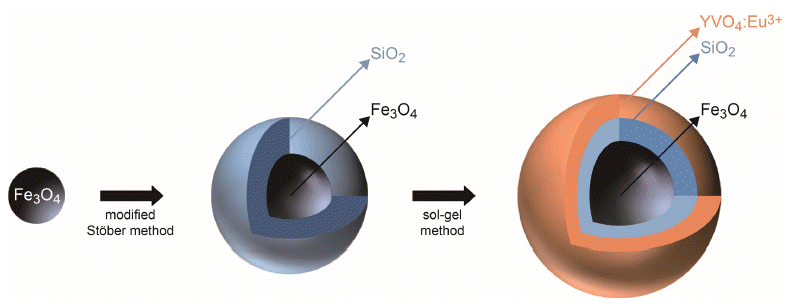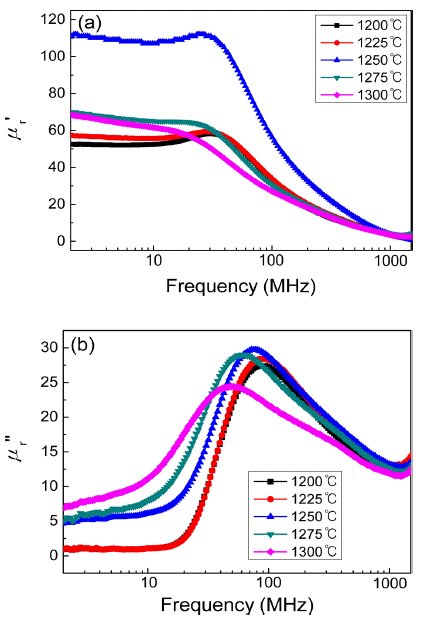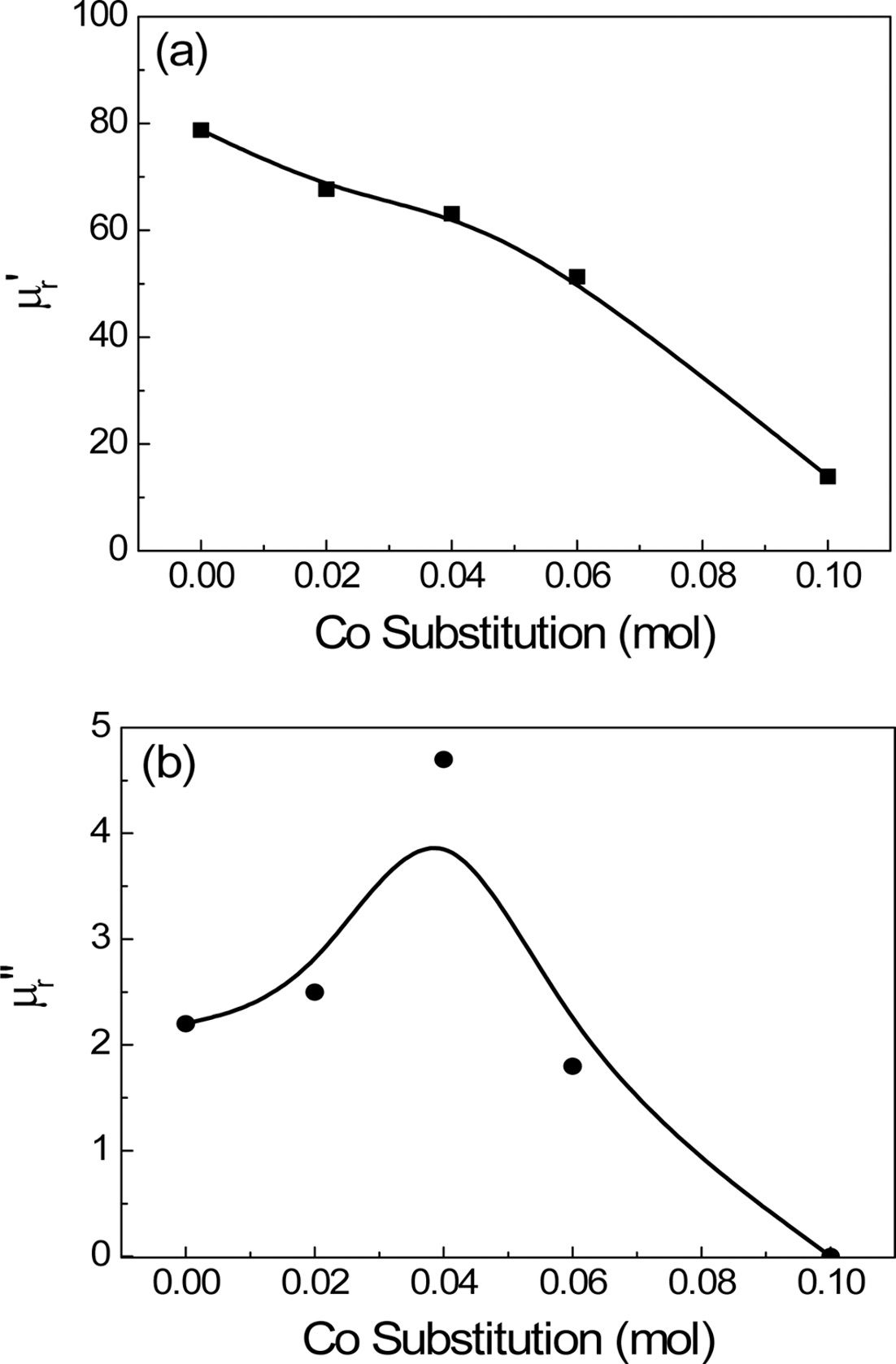Search
- Page Path
- HOME > Search
- [Korean]
- A Study on the Microstructure and Magnetic Properties of Fe83.2Si5.33-0.33
x B10.67-0.67x Px Cu0.8 Nanocrystalline Soft Magnetic Alloys with varying P Content - Hyun Ah Im, Kyoung-Hoon Bae, Yeong gyun Nam, Subong An, Sangsun Yang, Yong-Jin Kim, Jung Woo Lee, Jae Won Jeong
- J Korean Powder Metall Inst. 2021;28(4):293-300. Published online August 1, 2021
- DOI: https://doi.org/10.4150/KPMI.2021.28.4.293

- 689 View
- 8 Download
-
 Abstract
Abstract
 PDF
PDF We investigate the effect of phosphorous content on the microstructure and magnetic properties of Fe83.2Si5.33-0.33
x B10.67-0.67x Px Cu0.8 (x = 1–4 at.%) nanocrystalline soft magnetic alloys. The simultaneous addition of Cu and P to nanocrystalline alloys reportedly decreases the nanocrystalline size significantly, to 10–20 nm. In the P-containing nanocrystalline alloy, P atoms are distributed in an amorphous residual matrix, which suppresses grain growth, increases permeability, and decreases coercivity. In this study, nanocrystalline ribbons with a composition of Fe83.2Si5.33-0.33x B10.67- 0.67x Px Cu0.8 (x = 1–4 at.%) are fabricated by rapid quenching melt-spinning and thermal annealing. It is demonstrated that the addition of a small amount of P to the alloy improves the glass-forming ability and increases the resistance to undesirable Fex(B,P) crystallization. Among the alloys investigated in this work, an Fe83.2Si5B10P1Cu0.8 nanocrystalline ribbon annealed at 460°C exhibits excellent soft-magnetic properties including low coercivity, low core loss, and high saturation magnetization. The uniform nanocrystallization of the Fe83.2Si5B10P1Cu0.8 alloy is confirmed by high-resolution transmission electron microscopy analysis.
- [Korean]
- Development of Hybrid Insulating Coating for Fe-based Soft Magnetic Powder
- Jungjoon Kim, Sungyeom Kim, Youngkyun Kim, Taesuk Jang, Hwi-jun Kim, Youngjin Kim, Hyunjoo Choi
- J Korean Powder Metall Inst. 2021;28(3):233-238. Published online June 1, 2021
- DOI: https://doi.org/10.4150/KPMI.2021.28.3.233

- 483 View
- 6 Download
-
 Abstract
Abstract
 PDF
PDF Iron-based amorphous powder attracts increasing attention because of its excellent soft magnetic properties and low iron loss at high frequencies. The development of an insulating layer on the surface of the amorphous soft magnetic powder is important for minimizing the eddy current loss and enhancing the energy efficiency of highfrequency devices by further increasing the electrical resistivity of the cores. In this study, a hybrid insulating coating layer is investigated to compensate for the limitations of monolithic organic or inorganic coating layers. Fe2O3 nanoparticles are added to the flexible silicon-based epoxy layer to prevent magnetic dilution; in addition TiO2 nanoparticles are added to enhance the mechanical durability of the coating layer. In the hybrid coating layer with optimal composition, the decrease in magnetic permeability and saturation magnetization is suppressed.
- [Korean]
- Synthesis of the Multifunctional Core/Intermediate/Shell Nanoparticles: Tunable Magnetic and Photoluminescence Properties
- Mun-Kyoung Kim, Seyun Kim, Kyoung-Seok Moon, Weon Ho Shin, Hyung Mo Jeong
- J Korean Powder Metall Inst. 2019;26(6):463-470. Published online December 1, 2019
- DOI: https://doi.org/10.4150/KPMI.2019.26.6.463

- 536 View
- 3 Download
-
 Abstract
Abstract
 PDF
PDF Fe3O4/SiO2/YVO4:Eu3+ multifunctional nanoparticles are successfully synthesized by facile stepwise sol-gel processes. The multifunctional nanoparticles show a spherical shape with narrow size distribution (approximately 40 nm) and the phosphor shells are well crystallized. The Eu3+ shows strong photoluminescence (red emission at 619 nm, absorbance at 290 nm) due to an effective energy transfer from the vanadate group to Eu. Core-shell structured multifunctional nanoparticles have superparamagnetic properties at 300 K. Furthermore, the core-shell nanoparticles have a quick response time for the external magnetic field. These results suggest that the photoluminescence and magnetic properties could be easily tuned by either varying the number of coating processes or changing the phosphor elements. The nanoparticles may have potential applications for appropriate fields such as laser systems, optical amplifiers, security systems, and drug delivery materials.
- [Korean]
- Influence of Sintering Temperature on Magnetic Properties of Ni-Zn-Cu Ferrites Used for Mangetic Shielding in NFC
- Yo-Han Ryu, Sung-Soo Kim
- J Korean Powder Metall Inst. 2016;23(2):132-135. Published online April 1, 2016
- DOI: https://doi.org/10.4150/KPMI.2016.23.2.132

- 415 View
- 2 Download
-
 Abstract
Abstract
 PDF
PDF This study investigates the influence of sintering temperature on the magnetic properties and frequency dispersion of the complex permeability of Ni–Zn–Cu ferrites used for magnetic shielding in near-field communication (NFC) systems. Sintered specimens of (Ni0.7Zn0.3)0.96Cu0.04Fe2O4 are prepared by conventional ceramic processing. The complex permeability is measured by an RF impedance analyzer in the range of 1 MHz to 1.8 GHz. The real and imaginary parts of the complex permeability depend sensitively on the sintering temperature, which is closely related to the microstructure, including grain size and pore distribution. In particular, internal pores within grains produced by rapid grain growth decrease the permeability and increase the magnetic loss at the operating frequency of NFC (13.56 MHz). At the optimized sintering temperature (1225-1250°C), the highest permeability and lowest magnetic loss can be obtained.
- [Korean]
- Synthesis and Characterization of Nickel Nanowires by an Anodic Aluminum Oxide Template-Based Electrodeposition
- Hyo-Ryoung Lim, Yong-Ho Choa, Young-In Lee
- J Korean Powder Metall Inst. 2015;22(3):216-220. Published online June 1, 2015
- DOI: https://doi.org/10.4150/KPMI.2015.22.3.216

- 595 View
- 2 Download
-
 Abstract
Abstract
 PDF
PDF Vertically oriented nickel nanowire arrays with a different diameter and length are synthesized in porous anodic aluminium oxide templates by an electrodeposition method. The pore diameters of the templates are adjusted by controlling the anodization conditions and then they are utilized as templates to grow nickel nanowire arrays. The nickel nanowires have the average diameters of approximately 25 and 260 nm and the crystal structure, morphology and microstructure of the nanowires are systematically investigated using XRD, FE-SEM and TEM analysis. The nickel nanowire arrays show a magnetic anisotropy with the easy axis parallel to the nanowires and the coercivity and remanence enhance with decreasing a wire diameter and increasing a wire length.
- [Korean]
- High-frequency Magnetic Properties of Ni-Zn-Co Ferrites Used for Mangetic Shielding in NFC
- Yo-Han Ryu, Sung-Soo Kim
- J Korean Powder Metall Inst. 2014;21(6):429-433. Published online December 1, 2014
- DOI: https://doi.org/10.4150/KPMI.2014.21.6.429

- 490 View
- 0 Download
-
 Abstract
Abstract
 PDF
PDF This study investigated the magnetic properties and frequency dispersion of complex permeability of Ni-Zn-Co ferrites used for magnetic shielding in near field communication (NFC) system. The sintered specimens of (Ni0.7Zn0.3)1-xCoxFe2O4 composition were prepared by the conventional ceramic processing. The coercive force and saturation magnetization were measured by vibrating sample magnetometer. The complex permeability was measured by RF impedance analyzer in the range of 1 MHz~1.8 GHz. The coercive force increased and saturation magnetization decreased with increasing the Co substitution. The real and imaginary parts of complex permeability decreased and the resonance frequency increased with Co substitution, which was attributed to the increase in crystal anisotropy field and reduction in saturation magnetization. The effect of Co substitution could be found in reducing the magnetic loss to nearly zero at the operating frequency of NFC (13.56 MHz).
TOP
 KPMI
KPMI

 First
First Prev
Prev


